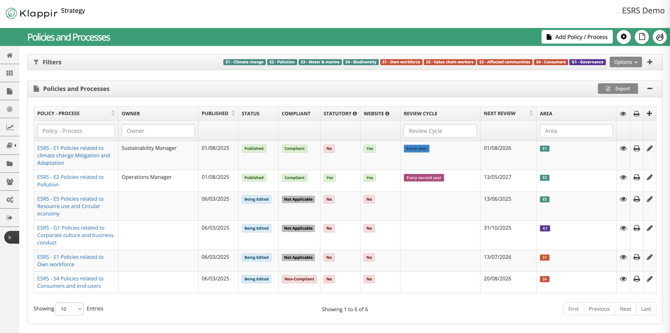2.3 How to Identify Gaps and Policy Improvement Needs
Review existing policies and flag areas for improvement
What You’ll Do
Once your policies and processes are entered into Klappir‑Strategy, this step helps you evaluate whether they:
-
Fully support your material topics
-
Meet the expectations of ESRS, VSME, or other relevant standards
-
Are complete, up to date, and effectively implemented
You’ll review each entry to identify missing, non-compliant, or outdated policies — and flag areas that need future improvement or action.
This forms the bridge to Step 3: Create objectives and Actions.
How to Do It – Step by Step
1. Open the Policies and Processes Module
-
Go to the module from the left-hand menu or the Dashboard
-
You’ll see your existing policy entries — either uploaded, written in the system, or linked externally

2. Review Policy Coverage by Material Topic
Check each entry for:
✅ Is there a policy for each material topic from your materiality assessment?
✅ Does the policy include clear governance, scope, and responsibility?
✅ Is the policy compliant with internal or external expectations (e.g. ESRS GOV-1–3, industry codes)?
✅ Is it up to date and scheduled for regular review?
💡 Tip: Use the Comments field to note any concerns, caveats, or reminders for improvement.
3. Use Status Fields to Flag Gaps or Weaknesses
Mark the policy status using the structured fields:
-
Being Edited – Policy exists but needs to be updated
-
Non-Compliant – Policy does not meet required standards
-
Compliant – Policy is in place and aligns with requirements
This helps your team and auditors understand where follow-up is needed — and supports action planning in Step 3.
Guidance and Good Practice
-
Not every topic needs a standalone policy, but there must be a clear and documented approach
-
Gaps are expected — especially for new or emerging topics. The key is to identify and document them
-
Policies with missing governance, outdated content, or vague commitments should be flagged for follow-up action
-
Use this assessment to plan policy updates, staff training, or new documentation needsin Step 3
📌 Align your gap analysis with ESRS GOV-1 to GOV-3 or the VSME module B2, which require documentation of:
Policy content and coverage
Implementation measures
Monitoring and review processes
Outcome of Step 2.4
By completing this step, you will have:
-
Reviewed each policy entry for coverage, quality, and compliance
-
Flagged missing, incomplete, or outdated policies
-
Identified which topics or policies need action, updating, or follow-up
-
Created a clear starting point for building your Sustainability Actions in Step 4
This ensures your ESG programme is built on a solid and traceable foundation, ready for internal control, stakeholder review, or future assurance.